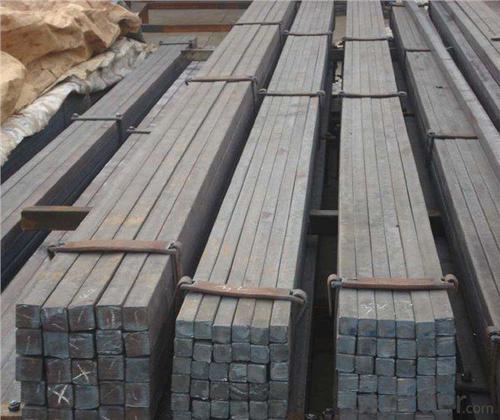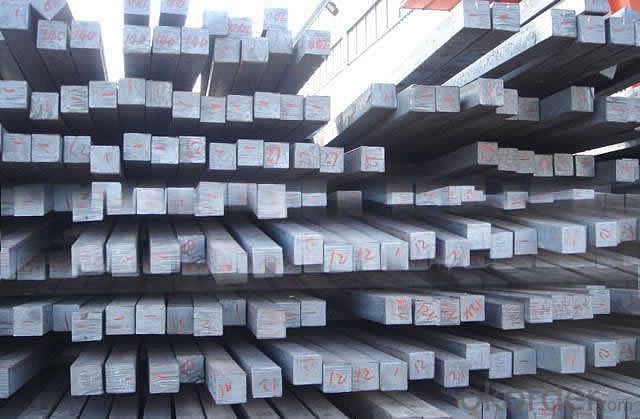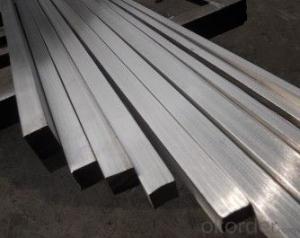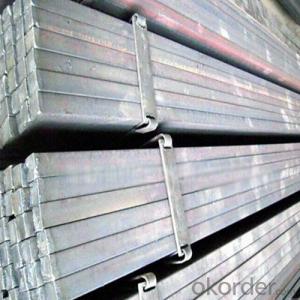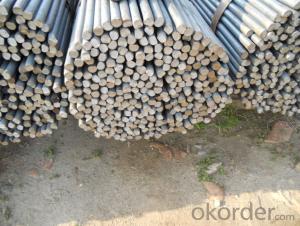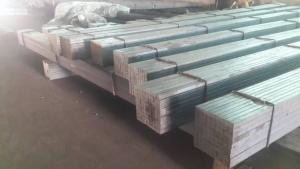Hot Rolled Square Bar with High Quality for Construction
- Loading Port:
- China main port
- Payment Terms:
- TT or LC
- Min Order Qty:
- 50 m.t.
- Supply Capability:
- 10000 m.t./month
OKorder Service Pledge
OKorder Financial Service
You Might Also Like
Product Description of Hot Rolled Square Bar with High Quality for Construction:
-Standard: GB,
-Grade: Q195 or equivalent.
-Chemical Composition:
Standard | Grade | Element (%) | ||||
GB | Q195 | C | Mn | S | P | Si |
0.06~0.12 | 0.25~0.50 | ≤0.050 | ≤0.045 | ≤0.30 | ||
Measures of HR Square Bar (small measures):
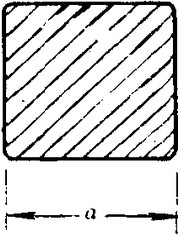
(Section of HR Square Bar)
-Length of a side and Theoretical weight of Square Bar.
Length of a side(mm) | Theoretical weight(kg/m) | Length of a side(mm) | Theoretical weight(kg/m) |
7 | 0.385 | 22 | 3.80 |
8 | 0.502 | 24 | 4.52 |
9 | 0.636 | 25 | 4.91 |
10 | 0.785 | 26 | 5.30 |
11 | 0.950 | 28 | 6.15 |
12 | 1.13 | 30 | 7.06 |
13 | 1.33 | 32 | 8.04 |
14 | 1.54 | 34 | 9.07 |
15 | 1.77 | 36 | 10.17 |
16 | 2.01 | 38 | 11.24 |
17 | 2.27 | 40 | 12.56 |
18 | 2.54 | 42 | 13.85 |
19 | 2.82 | 45 | 15.90 |
20 | 3.14 | 48 | 18.09 |
21 | 3.46 | 50 | 19.63 |
Notes:
1, The theoretical weights in the list, base on the density of 7.85 g/cm3.
2, Formula for theoretical weight of Square bar: (length of a side)2 * 0.00785
3, The numbers with *mean that they are not regular or we don’t offer them.
-Regular length of Square Bar:
Steel | Length of a side (mm) | Length of steel (m) |
Normal steel | < 25 | 4~10 |
> 25 | 3~9 | |
Steel of high quality | All measure | 2~6 |
Tool steel >75 | 1~6 |
Usage/Applications of Hot Rolled Square Bar with High Quality for Construction:
-The Square Bar is normally used as structure steel.
-Row material for other structure steel like steel angles, channels, I-beams, H-beams, etc…
Packaging & Delivery of Hot Rolled Square Bar with High Quality for Construction:
-Packing Detail: The products can be packed in bundles by steel wires.
-Marks: We make tag marks and color marks. The tag marks with white background and red company logo will be tied up to each bundle of the products. The information is usually including basic information of products and company and other information requested by customers. As for color marks, we will paint both ends of bundles to make sure that it will be more convenient for customers to distinguish them from other products.
-Delivery Detail: 30~45 working days after receive buyer’s T.T. or L/C.
Transportation of Hot Rolled Square Bar with High Quality for Construction:
-The products can be delivered by bulk vessel or by container. As for container, products with the length of 6m will be loaded in 20’ container, with 9m or 12m, in 40’ container.
-The maximum quantity of loading of container is 25 tons.
-The products are usually transported to the nearest port from the production place.
FAQ:
Q1: Why buy Materials & Equipment from OKorder.com?
A1: All products offered byOKorder.com are carefully selected from China's most reliable manufacturing enterprises. Through its ISO certifications, OKorder.com adheres to the highest standards and a commitment to supply chain safety and customer satisfaction.
Q2: How do we guarantee the quality of our products?
A2: We have established an advanced quality management system which conducts strict quality tests at every step, from raw materials to the final product. At the same time, we provide extensive follow-up service assurances as required.
Q3: How soon can we receive the product after purchase?
A3: Within three days of placing an order, we will begin production. The specific shipping date is dependent upon international and government factors, but is typically 7 to 10 workdays.
Images:
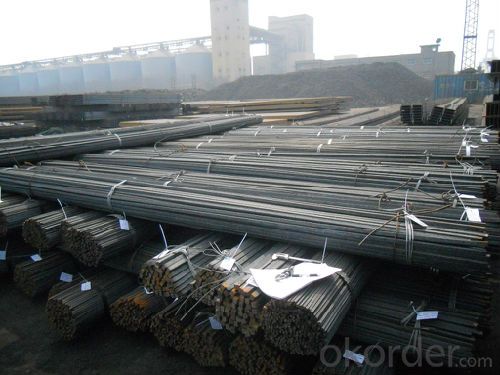
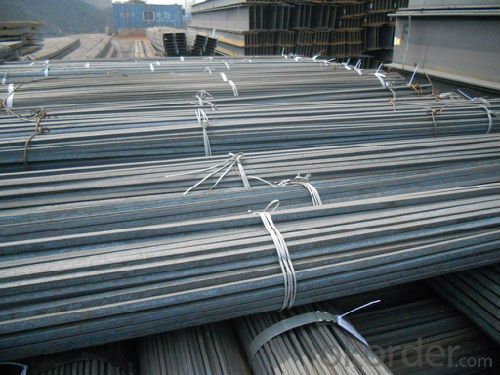
- Q: How does a steel square assist in marking out mortise and tenon joints?
- The steel square, a versatile tool, proves useful in various woodworking tasks, such as marking out mortise and tenon joints. The accuracy of these joints is crucial for a tight fit and strong connection. The steel square aids in achieving this level of accuracy by providing precise measurements and angles. To establish and maintain the required 90-degree angle for a square joint, one primary use of a steel square is in marking out mortise and tenon joints. The blade, the long edge of the square, is placed against the reference face of the workpiece, while the tongue, the short edge, aligns with the reference edge. By ensuring a firm position for both the blade and tongue against the reference surfaces, the square guarantees a perfect right angle for cutting the mortise and tenon. Moreover, the steel square serves for measuring and marking the dimensions of the mortise and tenon. The blade of the square contains a graduated scale, usually in inches or centimeters, allowing for precise measurements. By aligning the blade with the workpiece and using a marking knife or pencil, the width and depth of the mortise can be accurately marked. Similarly, the tongue can establish the width and length of the tenon, ensuring a proper fit between the two components. Additionally, a steel square aids in transferring layout marks from one piece to another. After marking the dimensions of the mortise and tenon on the first workpiece, the square can transfer these marks onto corresponding areas of the second workpiece. This ensures correct alignment of the mortise and tenon during joint assembly. In conclusion, the steel square proves indispensable in marking out mortise and tenon joints as it offers accurate measurements, assists in establishing right angles, and facilitates the transfer of layout marks. By effectively utilizing a steel square, woodworkers can ensure precise and well-fitting mortise and tenon joints, resulting in durable and robust woodworking projects.
- Q: Can a steel square be used for checking right angles?
- Yes, a steel square can be used for checking right angles. A steel square, also known as a framing square or carpenter's square, is a versatile and reliable tool used in woodworking, construction, and other trades. It consists of a long blade and a shorter tongue that meet at a 90-degree angle, forming a perfect right angle. By placing the square against the two surfaces that are supposed to be at right angles to each other, one can easily determine if the angle is truly 90 degrees. The accuracy and rigidity of a steel square make it an excellent tool for checking and ensuring right angles in various applications.
- Q: How do you use a steel square to measure and mark 219.375-degree angles?
- To use a steel square to measure and mark 219.375-degree angles, you would first need to locate the 0-degree mark on the steel square. This mark is typically found on the inside edge of the long side of the square. Next, align the long side of the square with the reference line or edge of the material you want to measure and mark. Ensure that the 0-degree mark is perfectly aligned with the starting point of the angle. Now, keeping the square fixed in position, rotate the material until the desired angle measurement of 219.375 degrees is reached. You can use a protractor or other angle measuring tools to assist you in accurately determining the angle. Once the angle is set, carefully mark the endpoint of the angle on the material using a pencil or a scribe. You can also use the edge of the steel square to create straight lines perpendicular to the angle as needed. It is important to note that steel squares typically have markings only for common angles like 45, 90, and 180 degrees. Therefore, measuring and marking angles that are not explicitly marked on the square, such as 219.375 degrees, may require additional tools or calculations.
- Q: Can a steel square be used for checking the squareness of window openings?
- Yes, a steel square can be used for checking the squareness of window openings. A steel square, also known as a framing square or a carpenter's square, is a versatile tool used in carpentry and construction for various applications, including checking the squareness of objects. When used to check the squareness of window openings, a steel square can ensure that the corners of the window frame are perfectly perpendicular at 90-degree angles. By placing the steel square against the corners of the window opening, one can easily determine if the corners are square or if any adjustments are necessary. The steel square's precise right angles and straight edges make it a reliable tool for checking the squareness of window openings and ensuring proper installation.
- Q: How do you use a steel square to mark cutting lines?
- To use a steel square to mark cutting lines, you first need to ensure that the square is clean and free from any debris or dirt. Then, place the square against the material you want to cut, making sure that the edge of the square is aligned with the desired cutting line. Next, hold the square firmly in place and use a pencil or a scribe to mark the cutting line along the edge of the square. Make sure to apply enough pressure to leave a visible mark, but not so much that it damages the material. If you need to mark multiple cutting lines parallel to each other, you can use the square's measurement marks or the heel of the square. Align the desired measurement mark or the heel of the square with the previous marking and repeat the process to create evenly spaced cutting lines. Once you have marked all the necessary cutting lines, double-check their accuracy before proceeding with the cutting process. It is essential to take your time and be precise when using a steel square to mark cutting lines to ensure accurate and clean cuts.
- Q: Can a steel square be used for checking the plumbness of a support column?
- Indeed, a support column's plumbness can be assessed using a steel square. Commonly employed in construction and carpentry, the steel square is an adaptable tool. Possessing a right angle, it allows for the examination of verticality or plumbness of surfaces. By positioning the steel square against the support column and aligning it with the surface, one can effortlessly ascertain if the column is straight or necessitates adjustments to achieve plumbness. Due to its reliability and precision, the steel square serves as an appropriate instrument for inspecting the plumbness of support columns.
- Q: How do you store a steel square to prevent rusting?
- To store a steel square and prevent it from rusting, you should follow a few simple steps: 1. Clean the steel square: Use a damp cloth or sponge to clean any dirt, debris, or grease from the steel square. Make sure to remove any moisture afterwards with a dry cloth to prevent water from causing rust. 2. Apply a protective coating: To provide an extra layer of protection against rust, you can apply a thin coat of oil or a rust-preventive spray. This helps to create a barrier between the steel and the air, preventing oxidation and rust formation. 3. Store in a dry location: Find a cool, dry place to store the steel square. Avoid areas with high humidity or moisture, such as basements or bathrooms. Moisture in the air can accelerate rusting, so it is essential to keep the storage environment dry. 4. Use a desiccant or moisture absorber: If you live in a particularly humid area or have concerns about moisture buildup, you can place a desiccant packet or a moisture absorber near the steel square. These products help to absorb any excess moisture in the air, reducing the risk of rust formation. 5. Avoid contact with other metals: When storing your steel square, make sure it does not come into contact with other metals, especially those prone to rusting. Different metals can create a galvanic reaction, accelerating rust formation. To prevent this, you can wrap the steel square in a soft cloth or store it in a protective case. By following these steps, you can effectively store a steel square and minimize the chances of rusting. Regularly inspect the square for any signs of rust or damage and reapply a protective coating if necessary.
- Q: Can a steel square be used as a level?
- No, a steel square cannot be used as a level. A steel square is primarily a measuring and marking tool used in carpentry, while a level is designed to determine if a surface is horizontal or vertical.
- Q: How do you use a steel square for checking corner squareness?
- To use a steel square for checking corner squareness, you would follow these steps: 1. Place the steel square against one corner of the object or surface you want to check for squareness. Ensure that the long edge of the square is flush with one side of the object or surface. 2. Hold the square firmly in place, making sure it doesn't move or shift during the measurement. 3. Extend the blade of the square along the adjacent side of the object or surface, ensuring it is parallel to the corresponding side. 4. Observe the intersection of the blade and the object or surface. If the corner is perfectly square, the blade should align perfectly with the adjacent side, forming a 90-degree angle. 5. If the corner is not square, you will notice a gap or overlap between the blade and the adjacent side. Take note of the amount of deviation from the desired 90-degree angle. 6. Repeat the process on all corners of the object or surface you want to check, ensuring that each corner is square. By using a steel square in this manner, you can easily determine whether a corner is perfectly square or not, helping you ensure accurate measurements and precise construction or alignment.
- Q: How is a steel square used in woodworking?
- A steel square is a versatile tool used in woodworking for various purposes. It is primarily used for measuring and marking right angles accurately. One common use of a steel square is to check the squareness of a project or workpiece. Woodworkers use it to ensure that the corners of a piece of furniture, such as a table or cabinet, are perfectly 90 degrees. This is crucial for ensuring the stability and overall quality of the finished product. Another way a steel square is used is for laying out and marking angles. By placing the square against the edge of a piece of wood, woodworkers can easily mark precise angles of 45 degrees, 30 degrees, or any other desired angle. This is particularly useful when cutting or joining wood pieces at specific angles, such as when building frames or joints. Additionally, a steel square can be used as a guide for making straight and accurate cuts. By aligning the square along the edge of the wood and running a saw or other cutting tool against it, woodworkers can ensure that their cuts are perfectly perpendicular to the surface. This is especially important for making clean and precise cuts, whether it's for creating joints or sizing lumber. Overall, a steel square is an indispensable tool in woodworking. It aids in achieving accuracy and precision in measuring, marking, and cutting wood, ensuring that the finished project is of high quality and meets the required specifications.
Send your message to us
Hot Rolled Square Bar with High Quality for Construction
- Loading Port:
- China main port
- Payment Terms:
- TT or LC
- Min Order Qty:
- 50 m.t.
- Supply Capability:
- 10000 m.t./month
OKorder Service Pledge
OKorder Financial Service
Similar products
Hot products
Hot Searches
Related keywords



